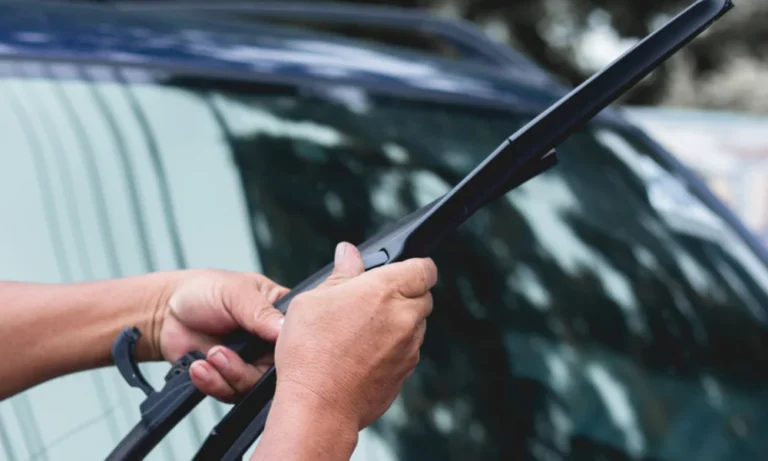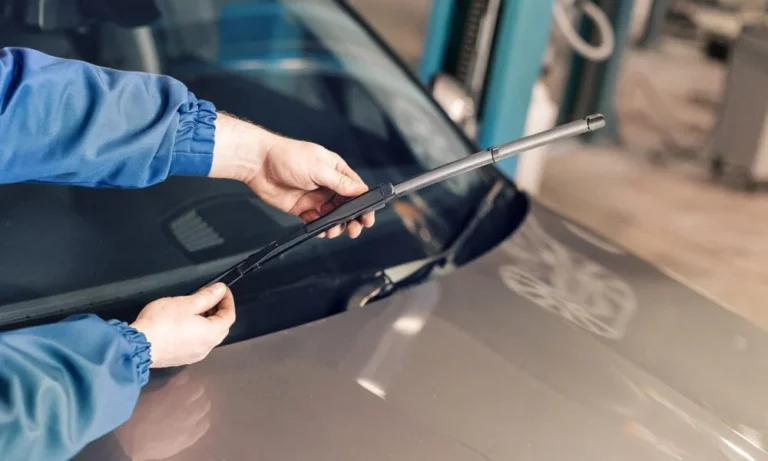How To Change A Windshield Wiper Arm
How to change a windshield wiper arm is a skill every driver should know, especially when dealing with worn or damaged components. The windshield wiper arm plays a crucial role in maintaining clear visibility during rain, snow, or other adverse weather conditions by holding the wiper blade in place and ensuring it moves effectively across the windscreen. Over time, the windscreen wiper arm can become bent, corroded, or lose tension, making it essential to replace the windshield wiper arm promptly. Driving with a faulty wiper arm can impair your vision, increasing the risk of accidents, particularly in poor weather. In this article, we’ll explain why a functional wiper arm is vital for safety, guide you step-by-step on how to replace a windshield wiper arm, and offer tips to ensure proper installation and maintenance.
When Should Windscreen Wiper Arms Be Replaced?

The windscreen wipers on your car are crucial for preserving vision in inclement weather, such as rain and snow. While wiper blades are often replaced regularly, the windshield wipers arm replacement is less frequent—but just as important when needed.
Signs Your Windshield Wiper Arm Needs Replacement
- Streaking or Skipping
If your wipers are leaving streaks or skipping across the windshield even after installing new blades, the issue might lie with the arm itself. A worn or misaligned arm won’t maintain proper pressure, causing poor contact with the glass. - Loose or Broken Arm
A broken wiper arm or one that wobbles or fails to move correctly likely needs replacement. A loose connection can prevent the wiper from clearing the windshield effectively or even cause it to stop working entirely. - Corrosion or Bending
Over time, exposure to the elements can cause the wiper arm to rust or bend. Corrosion can weaken the metal, and a bent arm may not follow the windshield’s contour, leading to inefficient wiping.
Wiper Blades vs. Entire Arm: What’s the Difference?
Replacing wiper blades involves swapping out just the rubber portion that makes contact with the glass. In contrast, windshield wipers arm replacement is necessary when the metal arm holding the blade fails due to damage, wear, or mechanical issues. If you’re unsure whether it’s the blade or the arm, a quick inspection by a professional can help determine the culprit.
Why Timely Replacement Matters
Neglecting a broken wiper arm can compromise your visibility and driving safety, especially during bad weather. Replacing the arm promptly ensures consistent pressure, smooth motion, and clear visibility, reducing the risk of accidents.
You can read about Windshield Wiper Scratch Repair.
What Are the Different Types of Windshield Wiper Arms?
When replacing a broken windshield wiper arm, it’s essential to understand the different types of wiper arm designs. Each type connects to the blade in a specific way, affecting compatibility with replacement parts.
Common Types of Windshield Wiper Arms
- Hook-Type
This is the most common wiper arm style. It has a curved end that resembles a hook, making it easy to install and secure most standard wiper blades. If you have a broken wiper arm of this type, replacements are typically widely available. - Pin-Type
A tiny pin that fits into the blade adapter is used by the pin-type arm. These are often found on older vehicles or European models. Identifying a broken windshield wiper arm with a pin-type connection usually requires checking the pin diameter for proper blade fit. - Bayonet-Type
Bayonet-style arms have a straight end that slides into the blade and locks in place with a tab. These arms are less common today but still found on some vehicles. Replacing a broken wiper arm of this type may involve a specific blade locking mechanism. - Side-Lock
The side of the arm that attaches to the blade of a side-lock arm has a locking mechanism. This type is often found on modern vehicles. When dealing with a broken windshield wiper arm, make sure to find a compatible side-lock adapter for the new blade.
How to Identify Your Vehicle’s Wiper Arm Type
To identify your wiper arm type:
- Check the owner’s manual.
- Examine the end of the arm where it attaches to the blade.
- Search your vehicle’s make, model, and year online for compatibility guides.
Recognizing the correct type is crucial—using the wrong blade for your arm type can result in improper installation or performance.
Compatibility with Wiper Blades
Each arm type is designed to work with specific blade adapters. If you’re replacing a broken wiper arm, ensure the new arm and wiper blades are compatible to maintain optimal windshield cleaning performance. You should also read about Why Does My Windshield Wipers Squeak.
How to Change a Windshield Wiper Arm (Step-by-Step Instructions)

Replacing a broken wiper arm is a straightforward DIY task that can restore your wipers’ performance and keep your windshield clear. Whether you’re dealing with a damaged unit or upgrading, follow these steps for a successful windshield wipers arm replacement.
Step 1: Park and Turn Off the Vehicle
Make sure you are parking your car on a level surface. For safety, turn off the ignition and take out the keys. It’s best to perform the replacement in daylight or a well-lit area.
The second step is to remove the old wiper arm from the windscreen.
Lift the wiper arm up and away from the window with caution. Most arms will stay upright due to spring tension. Be gentle to avoid snapping the spring or scratching the windshield.
Step 3: Remove the Retaining Nut or Locking Mechanism
Find the mounting location at the wiper arm’s base. You’ll typically find:
- A retaining nut (commonly hidden under a plastic cap), or
- A locking clip or button on newer models.
Use a socket wrench or screwdriver to loosen the nut or disengage the clip.
Step 4: Carefully Detach the Wiper Arm
Wiggle the arm gently side-to-side while pulling it away from the pivot. If it’s stuck due to rust or debris, apply a small amount of penetrating oil and wait a few minutes before trying again. This is a common issue with an older or broken wiper arm.
Step 5: Install the New Wiper Arm
Position the new windscreen wiper arm onto the wiper pivot, aligning it with the markings or original placement angle. Ensure it sits firmly in place.
- Tighten the retaining nut securely.
- If using a clip-style attachment, push the arm until you hear a “click.”
Check for a snug, stable fit before lowering the arm onto the windshield.
Step 6: Test the Wipers
Turn on your wipers briefly to ensure they move correctly and clear the windshield evenly. If they move awkwardly or make noise, recheck the alignment and mounting.
Can You Just Replace the Rubber Part of a Windshield Wiper?
Yes, you can—but it depends on the problem. Many drivers wonder whether it’s necessary to replace the entire wiper arm or if swapping out just the rubber refill is enough. Here’s what you need to know to make the right decision.
When Is Rubber Replacement Sufficient?
Replacing just the rubber refill (the blade insert) is often enough when:
- The wiper arm is intact and functioning correctly.
- The rubber is streaking, skipping, or squeaking, but the frame is not bent or corroded.
- You’re looking for a cost-effective solution to maintain performance.
Rubber-only replacements work well for maintaining clarity and visibility—as long as the wiper frame and arm are in good condition.
When Is Full Wiper Arm Replacement Needed?
Sometimes, replacing only the rubber isn’t enough. You’ll need a full windshield wipers arm replacement when:
- You have a broken wiper arm or damaged windscreen wiper arm that doesn’t apply proper pressure.
- The metal frame is bent, rusted, or wobbling.
- The wiper motor is working, but the arm isn’t moving the blade effectively.
In these cases, continuing to replace just the rubber won’t fix the issue, and you risk poor visibility during critical driving conditions.
Pros and Cons of Each Option
Option | Pros | Cons |
Rubber Refill Only | Low cost, environmentally friendly, quick to replace | May not solve deeper issues with pressure or alignment |
Full Arm Replacement | Solves mechanical issues, restores full functionality | Higher cost, more involved installation |
Cost Comparison
Replacement Type | Average Cost (Parts Only) |
Rubber Blade Refill | $5–$15 per blade |
Entire Wiper Blade | $15–$40 per blade |
Windshield Wiper Arm | $30–$80 per arm (plus labor if not DIY) |
Replacing a broken wiper arm or full windscreen wiper arm is more expensive than a rubber refill, but it’s a worthwhile investment when the issue is mechanical or structural.
Final Thoughts
Changing a windshield wiper arm is simple if you follow the right steps: park safely, lift the old arm, remove the nut or clip, detach the arm, install the new one, and test the wipers. If you’re dealing with a broken wiper arm or need expert help, don’t hesitate to reach out. At Texas Reliable Auto Glass, we’re here to make your windshield wipers arm replacement quick and hassle-free. Need assistance? Call us today or book your service online—your safety is our priority!
FAQs
How do I know if my windshield wiper arm needs to be replaced?
If your wipers are not moving properly, skipping, making unusual noises, or the blade isn’t contacting the windshield evenly, you may have a broken wiper arm that needs replacement.
Can I replace just the wiper blade, or do I need to change the whole arm?
You can replace just the blade if only the rubber is worn. However, if the arm is bent, rusted, or not functioning correctly, a full windshield wipers arm replacement is necessary.
What tools do I need to change a wiper arm?
Usually, you’ll need a socket wrench or screwdriver to remove the retaining nut or clip. Some models may also require pliers to detach the windscreen wiper arm from the pivot.
How long does it take to replace a wiper arm?
Replacing a wiper arm typically takes 10–20 minutes, depending on your vehicle and experience level.
Do I need to buy the same wiper arm model as my old one?
Yes. Always use a replacement that’s compatible with your vehicle’s make, model, and year. Using the wrong type may lead to improper fit or poor performance.

